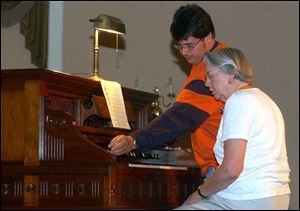
Village pulls out all the stops for reed organ expo
5/3/2004
Reed organ restorer Casey Pratt, standing, of Charles Town, W.Va., sets the stops for composer Marcia J. Hendron of Ocean Grove, N.J., at the reed organ festival in Fayette, Ohio. The Reed Organ Society event also attracted international visitors.
FAYETTE, Ohio - Being at the Fayette Opera House yesterday felt a little like sitting in church - only quieter.
A capacity crowd sat on wooden chairs as old tunes hummed from the organ in the corner.
But unlike most church organs, with tall pipes and electricity to pump the sound throughout the building, the opera house organ played a soft, subtle melody.
The performance on the harmonium, a member of the reed organ family, was part of a weekend festival celebrating the instruments that gave families music before their homes had power.
It was the first time the national celebration by the Reed Organ Society was held in this Fulton County community about 50 miles west of Toledo.
"It's a way for people to get to know the instrument," said Don Glasgow, an organizer of the event. "Some people here have 100 of them. Most have one or two."
Visitors came from Canada and Great Britain to hear and see the organs, and some hoped to buy an organ or sell or restore ones they owned.
Reed organs force air through metal reeds to make music. Stops control which reeds are opened, and the air is controlled by a series of foot pedals. They were popular in the 19th century, and production of reed organs ended by the 1960s.
Yesterday, people crowded into the opera house to get a look at the display or organs on stage. A black organ was barely as wide as the person who would play it. Another featured elaborately carved wood and towered above the others.
The harmonium, which three musicians played in the performance, had three rows of keys to produce subtle harmony during each song.
People came to the national festival for different reasons.
Mr. Glasgow said it gives people a glimpse into life when people didn't have electricity, but wanted to bring music into their lives.
"I've played the organ all my life, and then I learned to play this one," he said.
Restoration experts were on hand to help anyone interested in refurbishing. Mr. Glasgow restored an 1890 organ after it was donated by a Toledo man; it now resides at the opera house.
Isabel Perry of Sylvania said she came to the opera house to learn more about the organ her family found in an abandoned barn 50 years ago. She helped carry that reed organ across a snowy field to their house, and has been curious about it ever since.
Yesterday, she learned the organ came from Detroit, where production stopped around 1916.
Nothing compares to the sound a reed organ makes, she said.
"It makes all the difference in the world," she said.
Ms. Perry and the rest of the crowd spent the afternoon listening to three musicians play hymns, classical music, folk tunes, and even the theme to The West Wing on the harmonium.
The headliner was Michael Hendron, a former conservator at the Smithsonian Institute.
William Gill, organist and director of music at First Church Unity in Toledo, played folk tunes from around the world including Korea, China, Mexico, and Scotland.
Paul Monachino, director of liturgical music for the Diocese of Toledo and organist for the Rosary Cathedral, told the crowd about the organ and its music before he played several songs, including some by three French composers.
He said the harmonium was popular in homes when space or expense precluded pipe organs.
Contact Kelly Lecker at klecker@theblade.com or 419-724-6168.